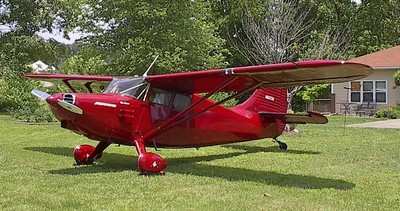Pilot Managed To Get Out Of The Airplane, But Did Not Survive
An accident last June involving a 66-year-old Stinson S108 may have been caused by a fractured piston. The NTSBs factual report on the accident, which resulted in the fatal injury of the airplane's pilot, Dr. Louis Hanson, shows one of the six cylinders in the S108's engine had fractured, throwing metal shrapnel into the engine's camshaft.

According to the factual report, on June 24, 2012, about 1155 eastern daylight time, a Universal Stinson 108, N39443, operated by a private pilot, was substantially damaged while ditching in the Atlantic Ocean, following a total loss of engine power during cruise flight near Portland, Maine. The private pilot was fatally injured. The personal flight was conducted under the provisions of 14 Code of Federal Regulations Part 91. Visual meteorological conditions prevailed and no flight plan was filed for the local flight that departed Twitchell Airport (3B5), Turner, Maine, about 1030.
According to data from the Federal Aviation Administration (FAA), the airplane was in radio and radar contact with Portland International Jetport (PWM), Portland, Maine, Approach Control. The airplane was flying along the coast near PWN, between 500 to 1,000 feet mean sea level (msl), from south to north. The pilot radioed that his intentions were to fly low for sightseeing and photography. At 1154, the pilot reported to PWM Approach that the airplane had experienced a total loss of engine power. At that time, the airplane was about 500 feet msl and the pilot indicated that he was not going to be able to glide the airplane far enough to reach the shore. The last radar target was recorded at 11:55:20, indicating an altitude of 200 feet msl.
According to an FAA inspector, the airplane impacted water approximately 100 yards from the shore and sank to a depth about 70 feet. The pilot exited the airplane and was able to don a lifevest that was dropped from a nearby helicopter; however, he was not able to inflate it. A boater subsequently retrieved the pilot and noted that he was unresponsive.
The pilot, age 60, held a private pilot certificate with a rating for airplane single-engine land. His most recent FAA third-class medical certificate was issued on November 11, 2010. At that time, the pilot reported a total flight experience of 504 hours. The pilot's logbook was not recovered.
The four-seat, high-wing, fixed-gear tailwheel airplane, serial number 108-13, was manufactured in 1946. The airplane was equipped with a Franklin 6A4-150-B31, 150-horsepower engine, serial number 13762. The pilot owned and operated the airplane. According to the aircraft logbooks, the airplane's most recent annual inspection was completed on November 4, 2011. At that time, the airplane had accumulated 2,114.5 total hours of operation. The engine had accumulated 1,727.5 total hours of operation and 7.5 hours since major overhaul, which was completed on February 9, 2007. The engine was originally installed on the airplane on August 1, 1947. At that time, the engine had accumulated 100 total hours since new. The airplane had flown approximately 10 hours since the most recent annual inspection.

According to the FAA inspector, a sheen of fuel was noted on the ocean surface when the airplane was recovered. Once the airplane was recovered, the inspector was able to confirm flight control continuity. He also noted that the airplane was not equipped with shoulder harnesses. The inspector was able to rotate the propeller by hand and confirm crankshaft, camshaft, and valve train continuity to the rear accessory section. A subsequent partial disassembly of the engine revealed that the No. 3 piston skirt had fractured. Pieces from the skirt entered into the engine, including into the camshaft gear, which affected the magneto timing.
During a telephone interview, the mechanic that overhauled the pistons in 2007 stated that he was not surprised that one failed as they were 60 to 70 years old. The mechanic added that as part of the overhaul procedure, he balanced the six pistons by ensuring they were the same weight. To do this, he used a precision gram scale to identify the lightest of the six pistons. He then removed weight from the other five pistons until they weigh the same as the lightest piston. The Franklin pistons were each equipped with a balance band, which was approximately 1/8 inch wide and 3/16 inch deep, located behind the piston skirt about 1 inch from the oil port. The mechanic removed material from the balance band by grinding it until he achieved the desired piston weight.
The No. 3 piston was forwarded to the NTSB Materials Laboratory, Washington, DC, for further examination. The metallurgical examination revealed that there were two fracture surfaces on the piston skirt, which were smeared with mechanical contact. The first surface smearing precluded the determination of a fracture mode. The second surface was less smeared and exhibited characteristics consistent with fatigue originating near a machined through-hole. The fatigue was not in the vicinity of the piston balance band.
(Stinson image from file. Not accident airplane)
 SpaceX to Launch Inversion RAY Reentry Vehicle in Fall
SpaceX to Launch Inversion RAY Reentry Vehicle in Fall Aero-News: Quote of the Day (04.23.24)
Aero-News: Quote of the Day (04.23.24) Aero-News: Quote of the Day (04.20.24)
Aero-News: Quote of the Day (04.20.24) ANN's Daily Aero-Linx (04.20.24)
ANN's Daily Aero-Linx (04.20.24) Aero-News: Quote of the Day (04.21.24)
Aero-News: Quote of the Day (04.21.24)




